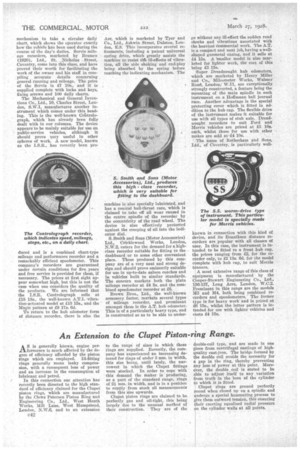An Extension to the Clupet Piston-ring Range.
Page 136

If you've noticed an error in this article please click here to report it so we can fix it.
Asis generally known, engine performance is much affected by the degree of efficiency afforded by the piston rings which are employed. III-fitting rings generally mean leaky compression, with a consequent loss of power and an increase in the consumption of lubricant and petrol.
In this connection our attention has recently been directed to the high standard of efficiency claimed for the Clupet piston rings, which are manufactured by the Clews Petersen Piston Ring and Engineering Co., Ltd., West Heath Works, Mill Lane, West Hampstead. London, N.W.6, and to an extension
C42
to the range of sizes in which these rings are supplied. Recently, the company has experienced an increasing demand for rings of under 3 ram. in width, this size being, until lately, the narrowest in which the Clupet fittings were stocked. In order to cope with this demand the maker is producing, as a part of the standard range, rings of 2-A. ram. in width, and is in a position to supply from stock all measurements from this size upwards.
Clupet piston rings are claimed to be perfectly gas and oil-tight, this being largely due to the unusual method of their construction. They are of the
double-coil type, and are made in one piece from centrifugal castings of highquality east-iron. The bridge formed by the double Coil avoids the necessity for a gap in the ring, thereby preventing any loss of power at this point. Moreover, the double coil is stated to be able to adjust itself to any variation from truth in the bore of the cylinder to which it is fitted.
Clupet rings are ground perfectly round when closed up on a spindle and undergo a special hammering process to give them outward tension, this ensuring their exerting equalised radial pressure on the cylinder walls at all points.




























































































































































































